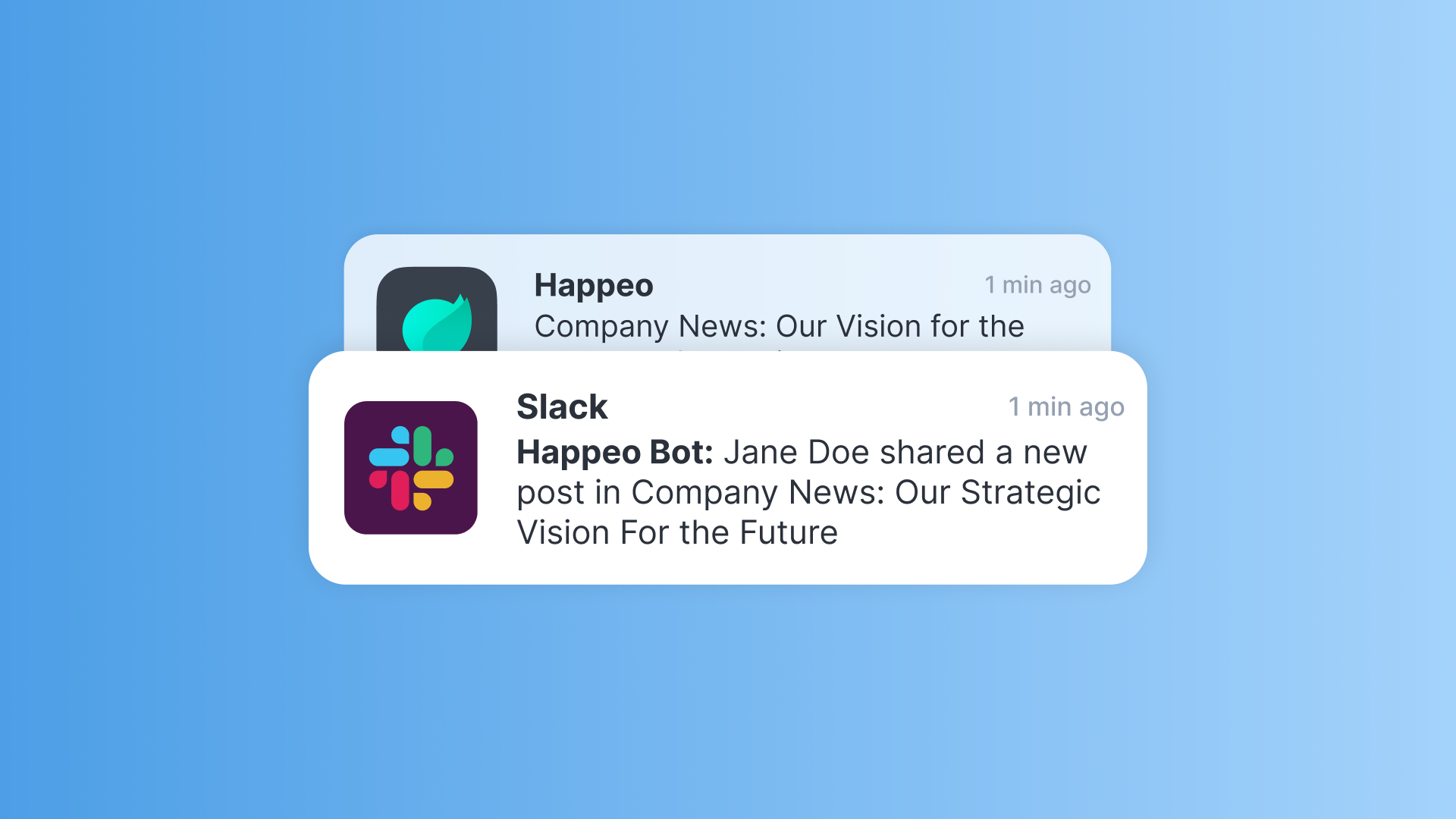
Internal Communications Comparisons
6 Reasons Why Your Slack Needs an Intranet

5 mins read
Start building your digital home with Happeo
Request a demoInternal Communications Comparisons
Product
Features
Solutions
Happeo for
Use cases
Resources
Explore
Support
Happeo For
Use cases
Comparisons
Explore
Support
Recent

Cara Heimbaugh
5 mins read
Slack has revolutionized the way we communicate, but its limitations can hinder productivity and knowledge sharing. While it's great for quick, informal chats, it falls short when it comes to structured communication, knowledge management, and long-term information retention.
Slack has powerful impact across business, but it’s not a robust platform for knowledge management or comms strategies. While attempting to stay lean, many organizations believe that they can use Slack for these use cases, but it’s not fit for those purposes. Let’s unpack some of the core limitations of Slack:
Overall, the constant stream of messages in Slack can quickly lead to information overload, making it difficult to find important announcements, policies, and crucial information. While Slack channels are useful for specific teams or projects, they lack a centralized platform for company-wide communication and knowledge sharing. Additionally, Slack's search function often falls short in providing comprehensive and accurate results, especially when dealing with large volumes of messages and files.
Slack isn't designed as a knowledge repository, leading to scattered important documents, best practices, and company policies. Finally, Slack lacks the tools and features to enforce content standards, control information flow, and prioritize important messages, resulting in inconsistent communication and a lack of control over the information landscape.
A central knowledge base is crucial for efficient knowledge sharing and retention. It provides a single source of truth for important information, policies, and best practices. Slack, while useful for real-time communication, lacks the hierarchy structure and organization necessary for effective knowledge management. There’s no “digital front page”, one place to focus on what’s most important, without an intranet. It's easy for vital information to get lost in the noise of countless channels and messages.
Slack falls short in providing a structured platform for critical internal communications. Slack's primary function is for quick, real-time chats, not for disseminating important company information. Consequently, essential messages can easily get lost in the constant stream of notifications and conversations. This lack of structure can lead to miscommunication, missed deadlines, and a general lack of accountability. Also, Happeo provides the ability to include read receipts on announcements, ensuring the most important messages are acknowledged.
Unlike Slack, Happeo offers a platform designed to prioritize and organize important information. With features like read receipts and acknowledgment of pinned posts, Happeo fosters a culture of accountability and ensures that critical messages are seen and understood by all employees. Additionally, longer-form content, such as company announcements or policy updates, can be easily shared and organized on Happeo without disrupting the flow of daily conversations. This level of structure and clarity is essential for maintaining a well-informed and aligned workforce, something that Slack simply cannot provide.
What if you never emailed your coworkers. Hard to imagine, right? But it’s possible. Many people are surprised to know that Happeo employees don’t use email at all, unless it’s to customers or external parties. How is this possible? A clear communications strategy and a firm understanding of what to use when.
Slack is best suited for short-term comms or one-off conversations that aren’t impactful past a moment. Email is best suited for external communications, and your intranet can (and should) provide the basis of collaboration and more formal internal communications. Happeo connects your comms to your knowledge base and offers a space to find accurate, up-to-date information and collaborate around that information in the same place, ensuring that everyone has the benefit of learning from other teams and colleagues.
If an intranet is a central source of truth, Slack is the wild, wild west. There’s truly no way of knowing which information is approved, accurate, or sanctioned by the organization. Conversations on Slack can quickly go from one topic to the next and involve topics that aren’t work related, whereas Happeo should be seen as a curated museum of trusted expert knowledge. This important knowledge should live in Happeo (or your intranet); when it’s there, employees can have confidence in its reliability.
Slack Channels sprout up constantly and are mainly to discuss specific projects, or communicate as a team. Happeo Channels are the basis for cross-departmental communication and collaboration, spaces for asking questions and creating threads that are searchable, organized, and helpful for all.
The average employee spends an entire work day per week simply tracking down the information or answers they need to do their jobs. It’s important to provide employees with the search experience they need to be successful and do their best work. Slack’s search capabilities are limited. With an intranet like Happeo, you can search from one place across your entire knowledge base, Drive, email, and integrations. Yes, including Slack. And with AI-powered Search, you can bypass the results lists and get curated answers with an accuracy rating and in any language.
With Slack, it's difficult to cut through the noise or get caught up. Employees need a tool that can help them find what's most relevant to them. Returning from vacation? Sifting through Slack can be a painful process, with many of the unread notifications being no longer important. Intranets like Happeo offer a better notification experience, helping people get up to speed faster and get on with their day, without the headache. Happeo's intelligent notifications prioritize important updates and filter out irrelevant noise, ensuring that employees only receive the information they need. This streamlined approach helps employees stay focused and productive, while also reducing the risk of missing critical information.
While each platform shines in their respective areas, Happeo and Slack are better together when it comes to elevating internal communications and knowledge sharing. Slack and Happeo complement each other by:
Slack and Happeo make too strong of a partnership to be competitors. Together, they help drive even more internal alignment and knowledge dissemination. By combining the strengths of both platforms, organizations can create a communication ecosystem that caters to the diverse needs of their employees. Happeo provides the foundation for a well-organized and informed workforce, while Slack enables efficient and agile collaboration. Together, they empower employees to work smarter, communicate more effectively, and drive innovation.